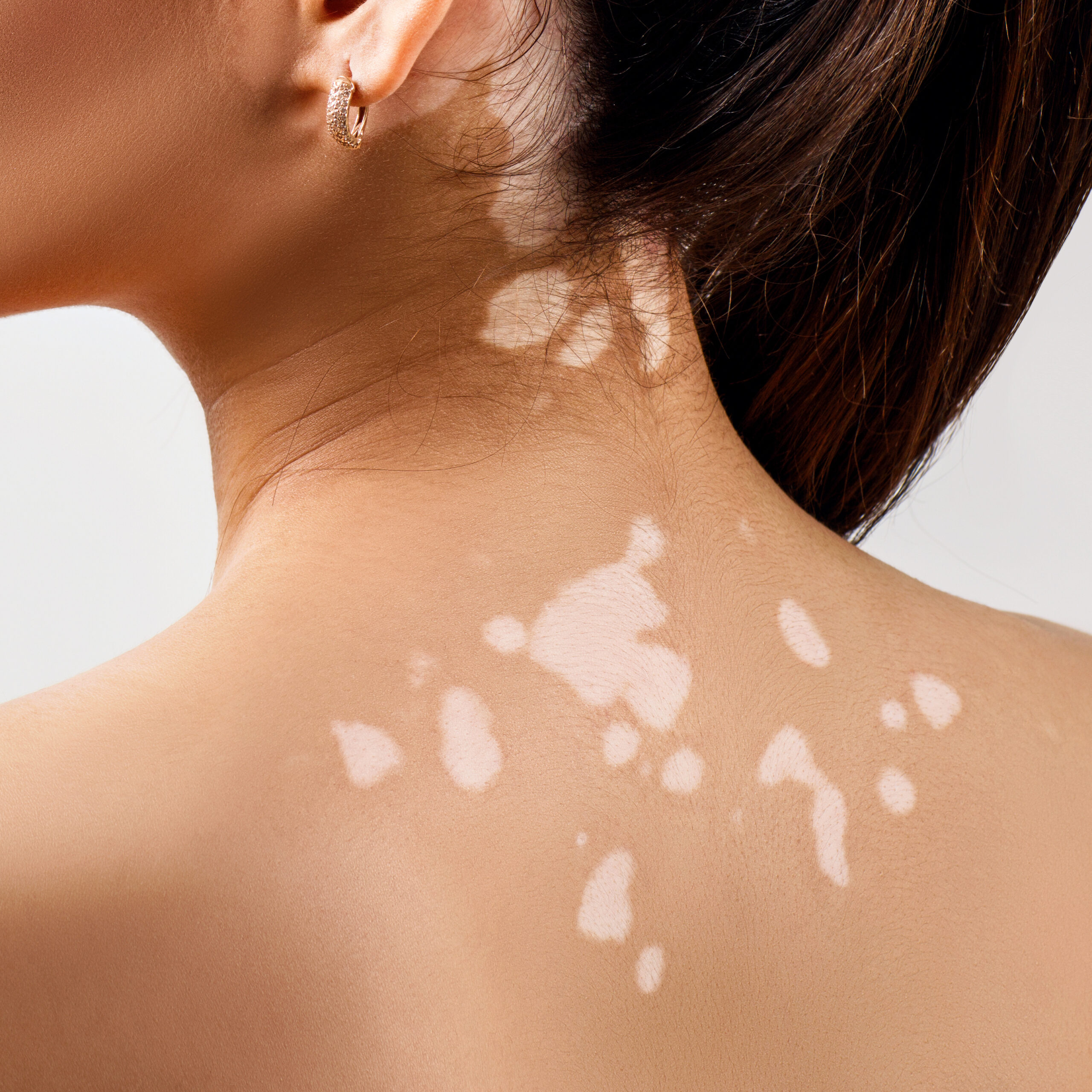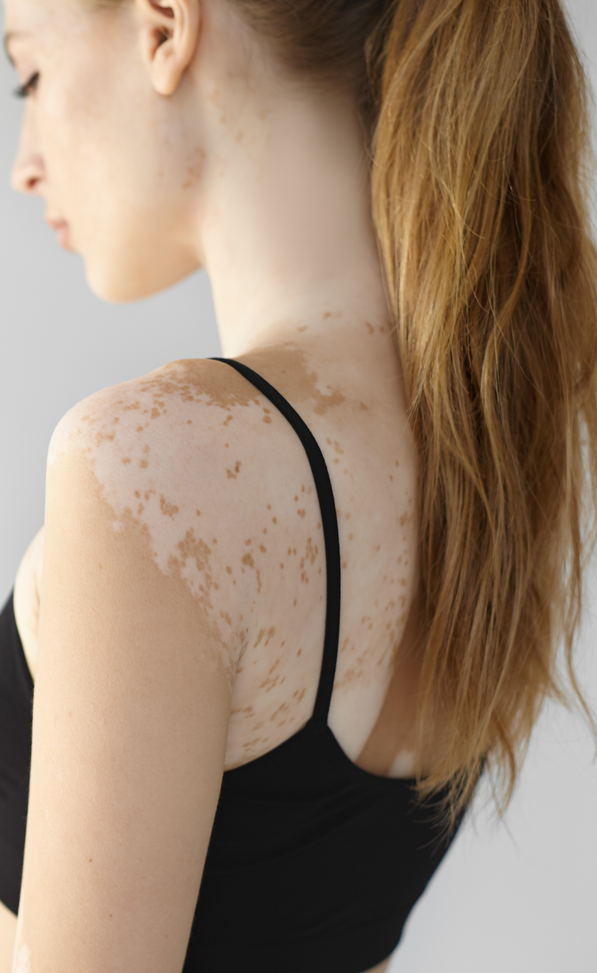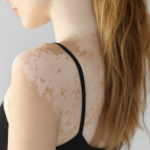Overview

Vitiligo is a chronic skin condition characterized by white patches on the skin, and is more apparent in those with a darker skin tone.
In vitiligo the pigment producing melanocytes are destroyed by the immune system. This causes the skin to lack melanin, which is responsible for the tone of our skin. Depigmented patches can appear anywhere on the body, and their size and distribution vary.
Causes

There are several factors believed to be related to vitiligo
- Autoimmune Response: It is suspected that in individuals with vitiligo, the immune system targets and attacks pigment-producing cells. This corresponds with research that shows approximately 15-20 percent of those with vitiligo also have another autoimmune disorder.
- Genetics: About 20% of people with vitiligo have a parent who also has it.
- Environmental Triggers: Vitiligo may begin as the result of an exposure to certain chemicals. In this case the exposure is known as a trigger event. Vitiligo could be triggered by infection, injury, or other autoimmune diseases.
Symptoms
The primary symptom of vitiligo is our natural skin tone developing white patches. They vary in size and can appear anywhere on the body. Other symptoms include:
- Gray hair: Hair in affected patches may turn white or gray. It might also change the color of eyelashes and eyebrows.
- Eye Problems: Vitiligo can result in eye problems, at times leading to inflammation in the iris or retina.
- Sunburn: This condition also can increase risk of sunburn as darker skin tones are the result of our melanin protecting the skin from UV rays.
- Hearing Loss: The American Academy of Dermatology states 12 to 38 percent of those with vitiligo have some level of hearing loss. This can come as a result of inflammation in the ear.
- Emotional Well Being: Looking different can impact an individual’s emotional well being. A loss of self esteem, and difficult social outcomes can be hard to deal with.

Diagnosis
Diagnosing vitiligo involves a visual exam by a dermatologist. The doctor may inquire about the patient’s medical history. Sometimes a skin biopsy, eye exam, or blood test may be used to confirm vitiligo.
- Visual Exam: A dermatologist may examine your skin under the light of a Wood’s lamp (black light), which makes vitiligo patches very easy to see.
- Skin Biopsy: By examining the skin for the missing melanocytes the dermatologist can confirm vitiligo.
- Eye Exam: Vitiligo can cause sensitivity to light or other uncomfortable symptoms in the eyes.
- Blood Test: Since vitiligo is an autoimmune disease, blood can confirm the presence of the disorder. Also, vitiligo has been linked to several other autoimmune diseases, so it is good to check for their presence as well during the process of diagnosing vitiligo.

Treatment
While there is currently no cure for vitiligo there are several treatment options of varying effectiveness. Choice of treatment depends on the severity of the condition and other individual factors.
- Topical Steroids: Corticosteroid creams or ointments can help reduce inflammation, and potentially restore some skin pigmentation.
Most recently the FDA approved a cream called ruxolitinib which has performed very well in clinical trials dated October 2023. In one study, “66.1% of patients saw a 75% improvement on what is called the Vitiligo Area Scoring Index (VASI).”, and at the same time side-effects were low.
- Topical Calcineurin Inhibitors: Medications like tacrolimus and pimecrolimus may be used to control inflammation and encourage repigmentation.
- Psoralen Plus Ultraviolet A (PUVA) Therapy: PUVA therapy combines a light-sensitive drug (psoralen) with ultraviolet A (UVA) light exposure to stimulate existing pigment in the skin.This treatment has decent results, and is exceeded by the following therapy in effectiveness.
- Narrowband Ultraviolet B (NB-UVB) Therapy: This treatment uses narrowband UVB light to repigment the skin.
- Excimer Laser: A popular choice of treatment, the excimer laser delivers targeted UVB therapy to vitiligo patches. There’s a variety of additional lasers being tested and released as well. Lasers can have side effects: skin lesions, blisters, or hyperpigmentation. Laser treatment can be costly without insurance, with one report from the American Academy of Dermatology Association as high as $3,900 per year.
- Surgical: In the event that medication and light therapy are ineffective, skin grafting and blister grafting are alternative techniques that can even out skin tone by restoring colour.
- Microskin and Dermablend: These are cosmetic camouflage techniques that can help mask the appearance of vitiligo. Microskin is a mixture of oil-based ingredients and ethanol that binds to the skin, and looks and feels natural.
Simcoderm Treats Vitiligo
At Simcoderm, we are experienced in treating vitiligo. We offer a variety of treatments based on the situational needs of the patient; however, we also conduct clinical trials to test modern treatment methods as well.
If that interests you, let us know and we can help you determine if it is right for you.


